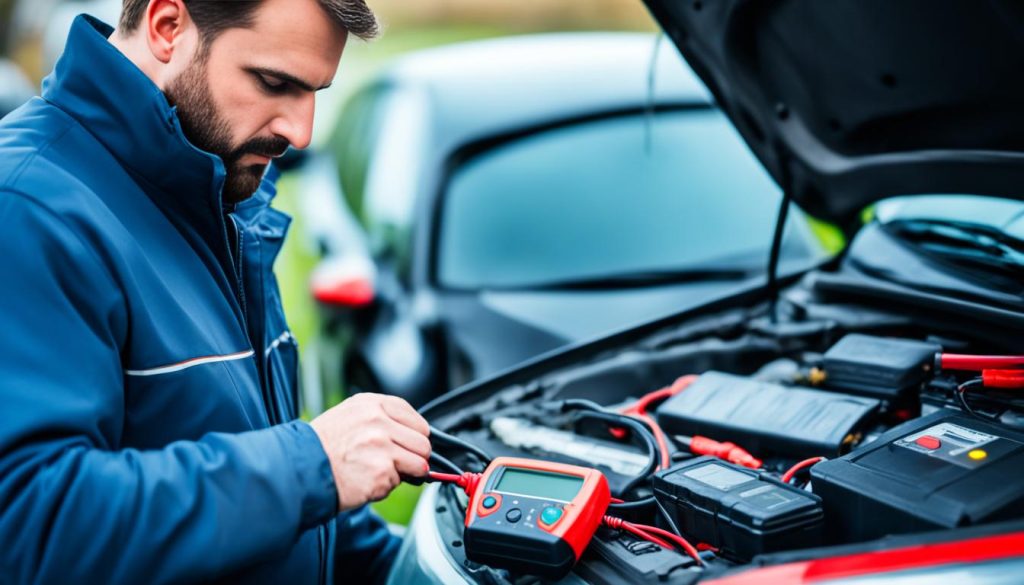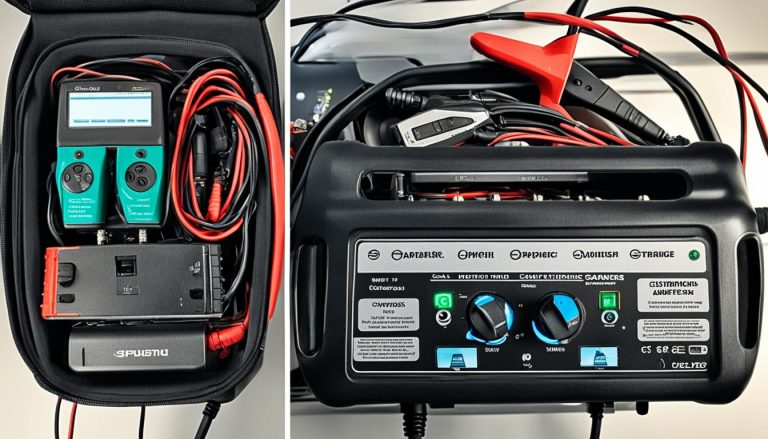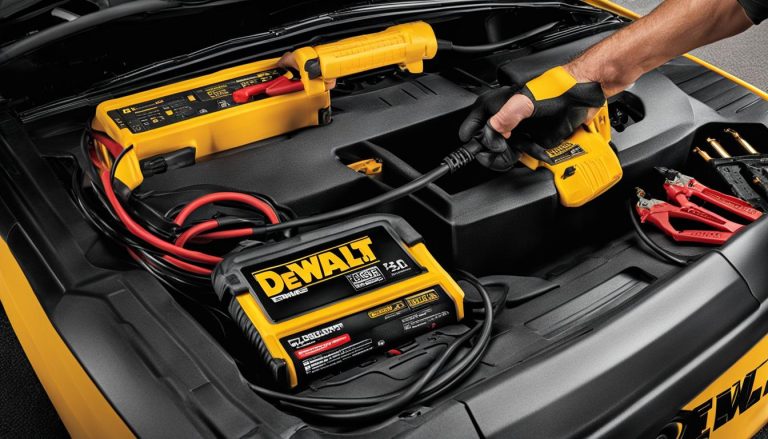Do You Need a New Battery After Jump Start?
batterychargers.site and its partners may earn a commission if you purchase a product through one of our links
Experiencing a car battery failure can be a perplexing situation, and you might wonder if a jump start battery replacement is necessary. It’s not uncommon for drivers to question the longevity of their car’s battery after a jump start. Concerns about car battery replacement after a jump start are valid, especially when you’re dealing with a battery that’s showing its age or hasn’t been performing optimally.
You’re right to pay attention to the signs your car is giving you post-jump. If your vehicle’s battery has been lagging even before the need for a jump start, it’s worth taking a closer look. Factors like battery age, maintenance history, and even your driving habits can all affect your jump start battery life. Let’s delve into these variables and determine whether it’s time to invest in a new battery, or if your current one still has some mileage left.
Key Takeaways
- Assess your battery’s age, as batteries older than 3-4 years are often less reliable.
- Look for signs of corrosion or wear that may necessitate a battery replacement.
- Understand that extreme temperatures can significantly impact battery performance.
- Be aware that a persistent inability to hold a charge post-jump may indicate a deeper issue.
- Check if your battery is still under warranty to address potentially faulty units.
Assessing Battery Health Post-Jump Start
After giving your car a necessary jump start, it’s crucial to recognize the signs of a bad battery which could indicate further action is needed. Dimming headlights or interior lights can be the first giveaway that your battery is on its last leg, often suggesting that it can’t hold a sufficient charge. Corrosion on terminals, which looks like white or greenish powder, disrupts the battery’s connection to the car’s electrical system—a red flag that maintenance is overdue.
Another telling sign is a swollen or misshapen battery case—a consequence of exposure to extreme temperatures—hinting at an internal failure and a potential safety hazard. Don’t ignore these warnings, as they can indicate that it’s time for a replacement to avoid any unexpected breakdowns.
Your dashboard could also be telling you critical information through illumination of the battery-shaped icon, cueing a necessary electrical system check. Moreover, if your car has been inactive and the battery is repeatedly dying, you may be at the point when to replace the battery after a jump start becomes pressing.
| Battery Status | Observation | Recommended Action |
|---|---|---|
| Dimming Lights | Headlights and interior lights lose brightness | Test battery and likely replace |
| Corroded Terminals | Beluga powder around battery contacts | Clean terminals and test battery performance |
| Deformed Case | Swelling or warping of the battery case | Replace battery to prevent potential dangers |
| Dashboard Warning | Battery symbol is lit on the dashboard | Consult a professional for an electrical system check |
| Repeated Death | Battery often dies after prolonged inactivity | Consider replacement to ensure reliability |
To ensure your safety and prevent getting stranded with a dead battery, keep an eye out for these warnings. Regular checkups by a certified mechanic will not only definitively tell you whether your battery merely needs recharging or if it’s time to bid it farewell but will also prolong the overall health and function of your vehicle’s electrical system.
Common Causes of Battery Failure and Jump Starting
When you find yourself with a dead car battery, understanding how to jump start it is essential. However, it’s equally important to identify the reasons why your car battery may have failed in the first place and to take the necessary precautions. Below we delve into how battery overuse can impact its lifespan, why your alternator might be involved in your battery’s woes, and how to deal with a potentially defective battery, also known as a “lemon” battery. Familiarizing yourself with these aspects can help you in jump starting a car battery precautions and in discerning how to know if battery needs replacement after jump start.
Understanding the Impact of Battery Overuse
Overuse is one of the most common causes of battery failure. Many drivers overlook the fact that using car accessories, such as headlights and the radio, without the engine running can severely drain the battery. After successfully jump starting your car, it’s advisable to keep the engine running and drive for an extended period to help recharge the battery fully.
Signs Your Alternator Might Be the Culprit
If you’re experiencing battery trouble not long after a jump start, and it’s not due to a “lemon” battery, your alternator may be at fault. The alternator is responsible for recharging your battery while your car is running. Signs of a faulty alternator include dimming headlights or dashboard lights and a whining or grinding sound coming from the engine.
Identifying and Dealing with a “Lemon” Battery
Sometimes a battery is just a “lemon”—in other words, it’s defective. Warning signs of a defective battery include a battery that can’t hold a charge right after purchase or seems to discharge too quickly. If you suspect a lemon, check your manufacturer’s warranty, as most will cover a replacement.

Documenting these concerns can help you when you need to discuss replacement options with your warranty provider. Below is a table comparing symptoms of battery failure, which can indicate when it’s time for a battery replacement.
| Symptom of Failure | Possible Cause | Solution |
|---|---|---|
| Battery not holding charge | Overuse without recharge | Drive for extended periods post jump start |
| Dimming headlights/dash lights | Potential alternator failure | Get the alternator checked |
| Quick discharge after purchase | Possibly a defective battery | Contact manufacturer for warranty service |
Maintaining the health of your car battery is crucial to avoid repeated jump starts. Understanding these common issues can steer you away from the inconvenience and cost of unexpected battery failure. Moreover, should you need to jump start your vehicle, remember to follow all the safety precautions to ensure a successful and safe procedure.
Do I need a new battery after jump start
When you’re faced with a vehicle that won’t start, a jump start is a go-to solution. However, what comes after can lead to questions about the health of your car’s battery. Let’s delve into whether jump start battery maintenance is sufficient, or if you need to consider replacing your battery entirely.
Evaluating Battery Age and Replacement Timing
One of the first considerations after restarting your vehicle is the battery’s age. Most car batteries have a lifespan of about three to five years. If yours is approaching this age or has surpassed it, it might be time to start shopping for a replacement. After a jump start, if you notice your battery struggles to hold a charge or lacks the cranking power it used to, these could be signs indicating the need for a new power unit.
How Corrosion Affects Your Battery’s Lifespan
Battery terminals are prone to corrosion, which can greatly impact the efficiency and functionality of your car’s battery. Regular checks for blue or white crusty buildups can forecast future problems. If significant corrosion is present, even after a jump start, do I need a new battery becomes less of a question and more of an eventuality. Addressing corrosion early can extend the life of your battery, but if it’s extensively damaged, replacement might be your only option.
The Influence of Driving and Maintenance Habits on Battery Life
Your driving habits also play a critical role in your battery’s longevity. Consistent short trips don’t give your battery enough time to fully recharge, which could eventually weaken it. To prevent early battery failure, regularly monitor driving patterns and perform jump start battery maintenance to ensure your battery always gets the full charge it needs. Keeping your vehicle’s electrical system in check is also crucial, as faulty components can drain a battery unpredictably.

- Check the battery’s age and prioritize replacement if it’s near the end of its lifespan.
- Inspect your battery for signs of corrosion, and clean the terminals as part of regular maintenance.
- Adjust your driving habits to allow full battery recharging, especially if you regularly make short journeys.
After a jump start, considering these factors will guide you in maintaining your battery’s health, or deciding if it’s time for a new one. Remember, a well-maintained battery not only ensures reliability but also saves you from unexpected expenses down the road.
Preventive Measures and Effective Battery Maintenance
If you’ve experienced the dread of a dead battery and relied on a jump start to get back on the road, it’s essential to take preventive measures to avoid a repeat predicament. **Jump start battery maintenance** starts with a simple yet crucial practice: ensure all electrical devices are turned off before you turn off the engine. This helps prevent any unnecessary drain on the battery’s power, safeguarding it against premature wear.
Next, reflect on your driving habits. Prolonged health of your battery isn’t just about reacting to **signs of a bad battery after a jump start**; it’s about active care and mindful usage. Frequent, short trips can prevent your battery from fully recharging, leading to a reduced lifespan. Strive for regular, longer drives to allow your battery to maintain optimal charge levels.
Moreover, routine checks can be a lifesaver. Regular inspections of the battery for signs of erosion, securing the connections, and ensuring no loose cables are paramount in battery care. When electrical issues arise, prompt attention is key to maintaining the integrity of your car’s electrical system. Following the recommended vehicle maintenance schedule can lead to a substantially longer battery life, mitigating the need for unexpected jump starts and untimely battery replacements.
FAQ
Do You Need a New Battery After a Jump Start?
Whether you need a new battery after a jump start depends on various factors. These include the age and condition of your battery, its maintenance history, and if it shows signs of corrosion or consistently fails to hold a charge. Often, a jump start is a temporary fix and if the problems persist, a battery replacement may be necessary.
How Can You Assess Battery Health After a Jump Start?
To assess your battery’s health post-jump start, look for warning signs such as dimming car lights, corrosion around the terminals, or a swelling battery case. If a battery-shaped warning light appears on your dashboard, it’s a clear indication that your battery needs to be checked.
What Are Common Causes of Battery Failure That Lead to Jump Starts?
Common causes of battery failure include leaving electrical accessories like headlights or the radio running when the engine is off, which can deplete the battery’s charge. Extreme temperature exposure and charging issues, often due to a failing alternator, can also lead to battery failure necessitating a jump start.
How Can You Understand the Impact of Battery Overuse?
Battery overuse occurs when you constantly drain the battery by using accessories without the engine running or by taking frequent short trips that don’t allow the battery to fully recharge. Over time, this can significantly shorten the battery’s lifespan and lead to more frequent jump starts or replacements.
What Are the Signs Your Alternator Might Be the Culprit?
Signs that your alternator may be failing include the battery dying shortly after being jump-started, dimming headlights and dash lights when your vehicle is running, and an electrical burning smell. If your car experiences these issues, have your alternator checked as it may be preventing the battery from charging.
How Can You Identify and Deal with a “Lemon” Battery?
A “lemon” battery is one that is defective despite being new. Signs include it dying soon after purchase or not holding a charge. It’s essential to check the warranty provided by the manufacturer; it may cover a replacement if the battery is indeed faulty.
When Should You Evaluate Battery Age and Replacement Timing?
You should evaluate your battery’s age and consider replacement if it is over 3-4 years old, which is typically when a car battery begins to deteriorate. If your battery starts showing signs of weakness, such as sluggish starts or needing jump starts often, it may be time for a replacement.
How Does Corrosion Affect Your Battery’s Lifespan?
Corrosion can affect your battery’s lifespan by interfering with the electrical connections necessary to start and run your vehicle. White, ashy deposits on the battery terminals are a sign of corrosion and can lead to poor battery performance or a failure to hold a charge.
How Do Driving and Maintenance Habits Influence Battery Life?
Your driving and maintenance habits greatly influence your battery life. Regularly driving short distances without allowing the battery to recharge fully, neglecting proper maintenance, and not addressing electrical issues can all contribute to the premature demise of your car battery.
What Preventive Measures Can Ensure Effective Battery Maintenance?
To maintain battery effectiveness and prolong its life, turn off all electrical devices before shutting off your engine, drive your car regularly to allow the battery to charge fully, check the battery for signs of corrosion periodically, and keep up with your vehicle’s maintenance schedule.






